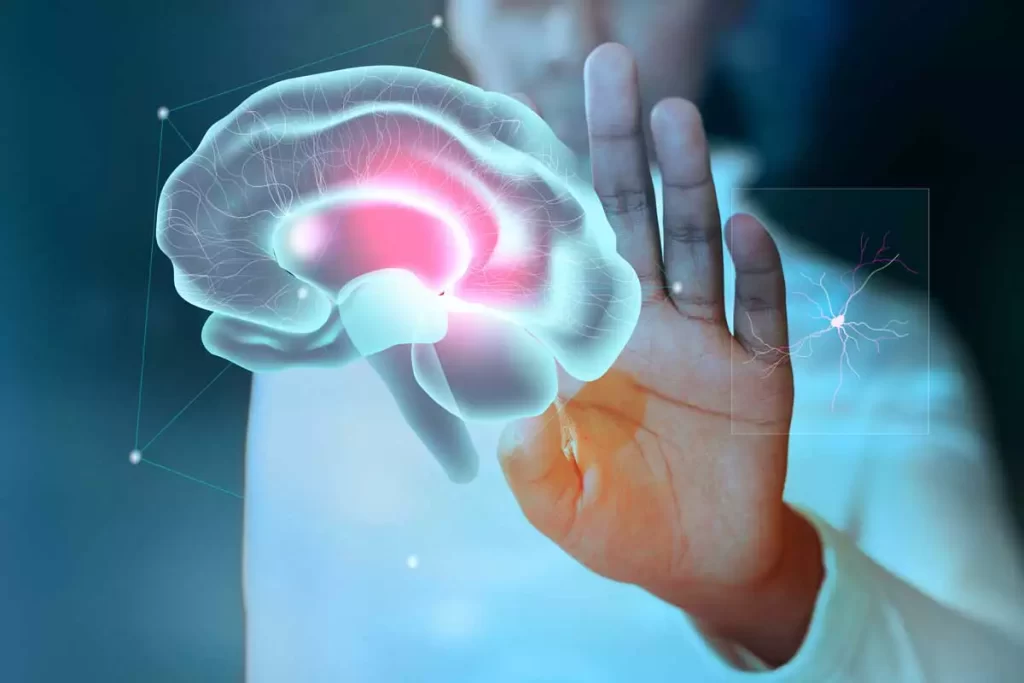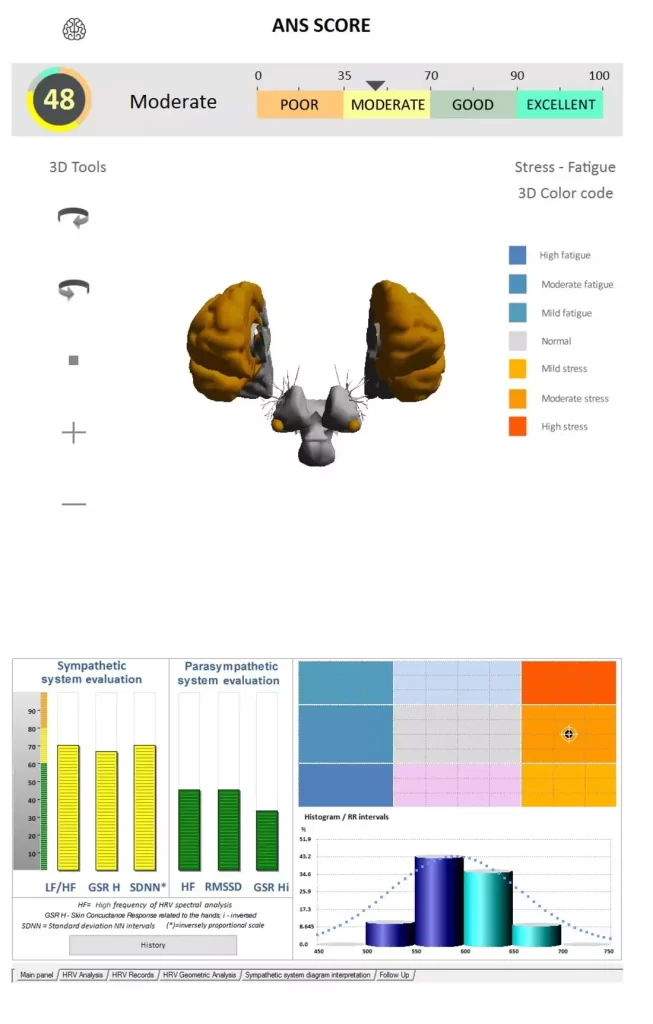
ANS Test Score By Ai Doctor
The Ai Doctor’s entire body scan shows the health of the Autonomic Nervous System (ANS) with the ANS Test Score. The health of the Autonomic Nervous System (ANS) is important because it controls 99% of all the body’s functions. For example, it regulates our heart rate, blood pressure, breathing, digestion, and sex drive without conscious thought.
The ANS comprises two sets of nerves–the sympathetic (SNS) and the parasympathetic nervous systems (PNS). These two systems work opposite each other. The sympathetic nervous system (SNS) prepares the body during stress. One example of this is by raising our heart rate. With our heart rate increased, blood is efficiently pumped to the muscles. Now, if there is an attack, our muscles are enabled to fight or flee to keep us safe.
The Impact of Stress on the Autonomic Nervous System
As we mentioned in the section above, the sympathetic part of our ANS keeps us safe from stressors. This was especially important to our ancestors. Because of the SNS, they could survive against predators and keep our species alive. The SNS elevates the heart rate, as we mentioned before. It also raises blood pressure by constricting blood vessels to bring more oxygen to the muscles. Because of this, muscles are tense and ready for rapid movement. Then, the liver creates more glucose (sugar) to boost energy. In the short term, where there is a physical threat like a tiger coming, these will help to save our lives. It is these bodily effects that the ANS Test Score uses to determine our current ANS health because our bodies cannot tell the difference between anxiety from a tiger or anxiety from a deadline.
While the sympathetic nervous system helps keep us alive, it can also lead to issues when the stressors do not disappear. The body, over time, can store stress because of work, finances, or relationship issues, which can damage the body. For example, elevated heart rate and blood pressure can increase the risk of strokes and heart attacks. Then, the constant muscle tension can cause pain, making over-the-counter pain killers a quick go-to. Additionally, the extra glucose in your system can lead to type 2 diabetes. In the short term, the ongoing stressors can cause insomnia, panic attacks, poor digestion, and anxiety. This is why the ANS Test score is an essential indicator for these long term and short term health risks.
The Importance of Balance
In today’s world, giving the body time to calm down from stressors is becoming more critical. When we do this, the parasympathetic nervous system (PNS) can do its work. This is why it is often called the rest and digest system. The PNS is responsible for the feelings of relaxation, eating, and sleeping. In addition, it decreases heart rate, increases body digestion, and controls urine and fecal output. If the parasympathetic functions optimally, it reduces the risk of heart disease and stroke. It also means that metabolism and gut health is in good shape. The ANS Test Score measures the PNS because it is also an indicator of overall well-being and stress levels.
The Ai Doctor’s ANS test score will show if the parasympathetic nervous system is out of alignment. One way to test this is to view your resting heart rate. Ideally, it should be in the range of 60 to 100. Then, notice how your heart rate increases and decreases based on the number of breaths you take per minute. The Ai Doctor ANS test score will detect this misalignment if you inhale and exhale pretty often and cannot take deep breaths.
The Assessment Of ANS Test Score

The ANS Test Score uses the data from the galvanic skin response and heart rate variability to get its results. These results begin with a 3D image of the brain and where stress and fatigue lie. These levels range from high fatigue, moderate fatigue, mild fatigue, normal, mild stress, moderate stress, and high stress. And each of these corresponds to a different color. When looking at the report, this specific user has moderate stress–meaning their SNS is hard at work.
The Sympathetic System Evaluation Chart
The ANS test score goes into further detail regarding the SNS in the Sympathetic System Evaluation charts. The LF/HF numbers are based on the heart rate variability data. LF (Low Frequency) measures the level of SNS activity (stress) and represents the power in beats/min2 in the low frequency range of the heartbeat. On the other hand, HF (High Frequency) measures the PNS activity (fatigue) and represents the power in beats/min2 in the high frequency range of the heartbeat. The LF/HF ratio then shows the balance of the sympathetic and parasympathetic areas of the nervous system. In this user’s results, their stress (LF) level is higher than their level of fatigue (HF). This lack of balance results in an overactive sympathetic nervous system, causing moderate stress.
Galvanic Skin Response
The ANS Test Score also uses the Galvanic Skin Response (“GSR H” related to the hand) to measure the intensity of anxiety/emotional arousal intensity. When a person experiences emotional triggers, they sweat, raising the skin’s electric conductivity. The limitation is that it cannot determine whether the emotion is positive or negative since both can elicit arousal. The GSR level of this user is high, indicating high levels of anxiety/emotional arousal.
The Standard Deviation of all intervals within a series of normal intervals in the heart rhythm (SDNN) can help indicate the regulatory responses of the autonomous nervous system. A high level means the parasympathetic system is working hard to regulate high stress levels. On the other hand, a low level means that the sympathetic nervous system is working to regulate high fatigue levels. This user’s ANS Test Score for this measure again indicates that they are under high stress.
The Parasympathetic System Evaluation Chart – ANS Test Score
The ANS Test Score not only measures the SNS it also measures the PNS. As we mentioned above, HF (power in beats/min2 in the high frequency range) represents the level of PNS activity. Therefore, despite the high stress levels, this client’s PNS activity is within the normal range.
The RMSSD in the ANS Test Score is the Root Mean Squared of successive differences between normal heartbeats. A high level typically reveals that the PNS can regulate the SNS well, thus indicating a higher fitness level. This client’s RMSSD is in the normal range despite the high stress levels.
Lastly, the GSR – Hi (Galvanic Skin Response) represents the inverse of the GSR-H. Since the GSR represents the intensity of arousal, the GSR-Hi is the reverse. Therefore, this number is not as significant as the GSR-H.
How do I have a healthy autonomic nervous system response?
The Ai Doctor ANS test score will recommend activities to help with autonomic nervous system scores. It is essential to practice activities that bring you peace and tranquility. For some people, this can be mindfulness-based practices such as yoga, meditation, deep breathing, exercising, or even simple walks in nature. However, we understand that this isn’t always suited for everyone. Other practical suggestions could include taking a hot bath or shower, playing relaxing music, reading a book, and doing activities that do not stress you out, such as watching a funny video or calling a friend. The goal is to ensure your environment is as relaxing as possible. Spending 10 minutes a day doing some of these activities will help calm the autonomic nervous system response and increase the ANS test score wellness. Try to listen to your body and gauge what will help you most destress.